|
|
|
Sort Order |
|
|
|
Items / Page
|
|
|
|
|
|
|
| Srl | Item |
| 1 |
ID:
167797
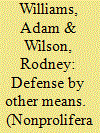

|
|
|
|
|
| Summary/Abstract |
This article discusses likely future contexts of, and options for, global threat-reduction activities to support nonproliferation goals over the next five to ten years. Threat-reduction activities span a continuum from unilateral actions that the United States might take with little cooperation and transparency at one end to cooperative actions associated with negotiated treaties and agreements at the other. This study focuses on cooperative approaches embodied in the Cooperative Threat Reduction (CTR) program, which has been the most visible program reducing the threats posed by weapons of mass destruction for over two decades. We argue that CTR’s evolution can be described in terms of the relationship between the desired US influence on outcomes, the ability to generate a common threat definition, and appetite for collaboration on threat reduction. To that end, this article provides an introduction and overview of CTR initiatives over its twenty-seven-year history and a review of relevant legislation and trends. After introducing and describing the CTR Possible Futures Framework, this article offers five possible options for—and discusses the implications of—CTR’s future evolution.
|
|
|
|
|
|
|
|
|
|
|
|
|
|
|
|
| 2 |
ID:
167792
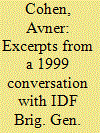

|
|
|
|
|
| Summary/Abstract |
During the 1967 crisis, Yitzhak Ya’akov (nicknamed Ya’tza) was the senior Israeli Defense Force (IDF) staff officer in charge of weapons development, and as such acted as the chief liaison between the IDF and all civilian defense industries, including the nuclear project. This edited transcript documents one of a series of conversations that Avner Cohen had with Ya’tza, in Hebrew, in the summer of 1999 at Ya’tza’s residence in New York City. A longer version, slightly redacted due to security and privacy considerations, was posted on the website of the Nuclear Proliferation International History Project (NPIHP) in 2017.
|
|
|
|
|
|
|
|
|
|
|
|
|
|
|
|
| 3 |
ID:
167796
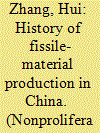

|
|
|
|
|
| Summary/Abstract |
This article reconstructs the history of China’s production of highly enriched uranium and plutonium for nuclear weapons based on newly available public sources. It begins with discussion of China’s first set of fissile-material production facilities, which China started building in 1958. It then details the first and second “third-line” construction campaigns, initiated in 1964 and the late 1960s, respectively. Finally, the article considers the policy implications of the history of China’s fissile-material production, particularly its influence on China’s attitude toward negotiating a fissile-material cutoff treaty.
|
|
|
|
|
|
|
|
|
|
|
|
|
|
|
|
| 4 |
ID:
167787
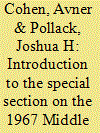

|
|
|
|
|
| Summary/Abstract |
Public understanding of the nuclear dimensions of the June 1967 Middle East War has progressed considerably since the late 1990s. Then, Israeli researchers showed that the vulnerability of Israel’s nuclear facility at Dimona to Egyptian air power played a significant role in the thinking of Israel’s military and political leaders during the crisis of May and early June. This issue’s special section offers significant new advances in addressing unresolved questions about the role of Israel’s nuclear program during these events. Did Egypt’s leaders actually have designs on Dimona, and how did their thinking about Dimona change over the course of the crisis? How close was Israel to possessing a usable nuclear device on the war’s eve? In what manner and circumstances might Israel have detonated its nuclear device? Did the US government know or suspect that Israel had an underground reprocessing plant adjacent to the Dimona reactor, enabling it to separate plutonium and build nuclear devices?
|
|
|
|
|
|
|
|
|
|
|
|
|
|
|
|
| 5 |
ID:
167789


|
|
|
|
|
| Summary/Abstract |
At the time of the 1967 Arab-Israeli War, top US policy makers did not believe that Israel had produced nuclear weapons. Since the discovery of the Dimona reactor complex in 1960, senior US officials and intelligence experts took it for granted that the Israelis sought a nuclear-weapon capability, but a wall of secrecy surrounded the reactor. Even inspection visits by US nuclear experts left important questions unanswered. A central problem was whether Israel had acquired or would acquire the reprocessing plant needed to produce plutonium. While the original plans for Dimona included an underground reprocessing plant, it was deeply secret. A few months before the war, State Department intelligence experts suspected that the Israelis had begun reprocessing and could even have stockpiled a few devices, but this perception was not shared at the top. The Lyndon B. Johnson administration would have been profoundly shocked if US intelligence had discovered the secret assembly of nuclear devices in May 1967. Strict secrecy in Israel may have averted a crisis in US–Israeli relations.
|
|
|
|
|
|
|
|
|
|
|
|
|
|
|
|
| 6 |
ID:
167791


|
|
|
|
|
| Summary/Abstract |
Elie Geisler received training as a radiation-safety officer while serving as a solider at Dimona from 1964 to 1966. As the crisis escalated in late May 1967, Geisler was summoned to meet the head of the Minhal Madaii—the secret scientific administration in charge of the nuclear project—who gave him a special assignment: guarding a radioactive “package” to be placed under heavy security. The following testimony was relayed to Avner Cohen through several interviews, follow-up conversations, and email exchanges.
|
|
|
|
|
|
|
|
|
|
|
|
|
|
|
|
| 7 |
ID:
167793
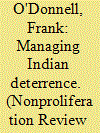

|
|
|
|
|
| Summary/Abstract |
India is developing new nuclear force options in response to what it perceives as a deteriorating strategic environment. New Delhi has historically adhered to the nuclear strategic concept of “credible minimum deterrence,” defined as maintaining a small, survivable nuclear force at low readiness in peacetime, which poses a credible risk of nuclear retaliation to adversaries but does not guarantee it. However, India’s stated commitment to credible minimum deterrence is currently challenged by four specific developments: the gradual weakening of elite support for India’s no-first-use policy; the decision of its defense scientific agency to pressure policy makers by publicly announcing it can field tactical nuclear weapons; the shift of Indian Air Force planning toward potential counterforce strikes; and New Delhi’s unclear intentions concerning ballistic-missile defense. This article concludes that India faces a choice between two distinct nuclear-policy pathways: retaining its adherence to credible minimum deterrence, or permitting increasing ambiguity surrounding its true nuclear doctrine and posture. The article evaluates these nuclear-policy options and concludes that credible minimum deterrence remains more consistent with Indian national-security and foreign-policy goals.
|
|
|
|
|
|
|
|
|
|
|
|
|
|
|
|
| 8 |
ID:
167790
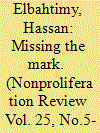

|
|
|
|
|
| Summary/Abstract |
Did nuclear considerations play an important role in the outbreak of the 1967 Arab-Israeli War? This research article seeks to answer this question by examining Egyptian decisions and conduct during the crisis preceding the war. The article argues that, despite long-standing Egyptian concerns over Israeli nuclear ambitions, the issue played only a marginal role in Egypt’s path to war. Egypt’s slide into war was a result of miscalculation rather than a deliberate plan to destroy Dimona. During the pre-war crisis, the nuclear dimension played only a minor role in Egyptian military planning. While a contingency plan to target Dimona was studied, it was never implemented. The article predominantly draws on Arabic-language sources, including first-hand accounts of Egyptian decision making during the pre-war crisis.
|
|
|
|
|
|
|
|
|
|
|
|
|
|
|
|
| 9 |
ID:
167788
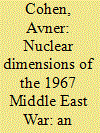

|
|
|
|
|
| Summary/Abstract |
For many years, the nuclear dimensions of the 1967 Middle East War were unacknowledged and obscure. In the last two decades, however, bits and pieces of evidence have surfaced about this issue. This article reviews and assesses the current state of knowledge on these aspects of the pre-war crisis, i.e., what we know with confidence, what we suspect, and what remains unknown. The first section explores the prewar background: the state of Israel’s nuclear project as well as the Israeli perception of Dimona as a possible trigger for war. The second part deals with the two nuclear dimensions of the crisis itself. The first is the role of Dimona in shaping, even precipitating, the Israeli response to the crisis. The second is the crash nuclear-related activity that took place during the crisis. The article reviews recent testimonies on how Israel assembled its first nuclear-explosive device while exploring operational ideas for improvising a “last resort” demonstration.
|
|
|
|
|
|
|
|
|
|
|
|
|
|
|
|
| 10 |
ID:
167794
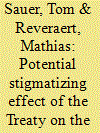

|
|
|
|
|
| Summary/Abstract |
On July 7, 2017, seventy-two years after the start of the nuclear era, 122 states concluded the Treaty on the Prohibition of Nuclear Weapons (TPNW, or “ban treaty”). The treaty forbids the development, production, acquisition, possession, transfer, testing, use, and threat of use of nuclear weapons. Advocates of the TPNW understand that it will not automatically lead to a world without nuclear weapons. The treaty’s main goal is to stimulate a societal and political debate inside the nuclear-armed states and their allies by strengthening the antinuclear norm and by stigmatizing nuclear weapons and their possessors. This article assesses to what extent this process of stigmatization might take place. It starts by elaborating on the concepts of stigma and stigmatization. It then matches the concept of stigma with nuclear weapons, and with the humanitarian initiative behind the momentum that led to the TPNW. The article concludes by looking to different stigma-management approaches that can be used by the nuclear-armed states and their allies.
|
|
|
|
|
|
|
|
|
|
|
|
|
|
|
|
| 11 |
ID:
167795
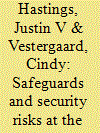

|
|
|
|
|
| Summary/Abstract |
Historically, there have been limited international controls at the very front end of the nuclear fuel cycle, which consists of mining, processing, transportation, and conversion of natural uranium. However, an evolving framework of nuclear-security treaties along with International Atomic Energy Agency clarifications of the materials subject to its safeguards obligations are increasing the coverage of source materials, raising the question of how new and traditional uranium suppliers should handle safeguards and security in the production of uranium. We use a risk framework to assess the likelihood and consequences of different proliferation risks. Although the consequences for proliferation are generally low, risks to the very front end are different for safeguards (state diversion) and nuclear-materials security (unauthorized removal by non-state actors). For safeguards risks, cases of diversion or undeclared activities are concentrated at conversion facilities, while theft or trafficking of front-end material represents a relatively small percentage of total security incidents, concentrated in countries with lower levels of nuclear-materials security. We conclude that safeguards and security obligations should be commensurate with the risks. An appropriate response should involve a risk-based, graduated approach to nuclear security and a flexible, more clearly framed approach to safeguards.
|
|
|
|
|
|
|
|
|
|
|
|
|
|
|
|
| 12 |
ID:
167798


|
|
|
|
|
| Summary/Abstract |
Drone swarms—multiple unmanned systems capable of coordinating their actions to accomplish shared objectives—have major implications for the future of warfare. One important set of implications relates to the ability of drone swarms to complement, challenge, and even substitute for chemical, biological, radiological, and nuclear (CBRN) weapons. For example, swarming drones might enable more effective CBRN delivery. Or they might facilitate standoff detection, search the oceans for nuclear-armed submarines, or otherwise impede an adversary’s ability to threaten or employ CBRN weapons. Conventionally armed drone swarms might serve as strategic deterrents in lieu of CBRN weapons. At the same time, many CBRN-relevant applications of drone-swarm technology entail significant technical challenges even for very sophisticated states, and even more so for non-state actors whose capabilities will be far more limited, so there is considerable uncertainty around whether, how much, and when drone-swarm technology will complement, challenge, or substitute for CBRN weapons.
|
|
|
|
|
|
|
|
|
|
|
|
|
|
|
|
| 13 |
ID:
167799


|
|
|
|
|
| Summary/Abstract |
United Nations Security Council resolution (UNSCR) 1540, adopted unanimously under Chapter VII of the UN Charter in 2004, is a key component of the global security architecture, enumerating specific obligations for states, which ultimately aims to reduce the overall risk of weapons-of-mass-destruction proliferation. However, although nearly fifteen years have passed since the adoption of the resolution, many states have still not implemented many of its requirements and obligations—meaning that at least some of the vulnerabilities and risks identified over a decade ago likely still exist, or have changed and expanded over time. This viewpoint discusses the establishment of dedicated UNSCR 1540 coordinators in regional organizations as an example of an effective practice that may contribute toward achieving full implementation of the resolution, fully consistent with established US policy. Since some regional organizations may not have the financial and administrative capacity, or political will, to host such a position, this viewpoint also proposes a variety of ways to address these shortfalls.
|
|
|
|
|
|
|
|
|
|
|
|
|
|
|
|
|
|
|
|
|